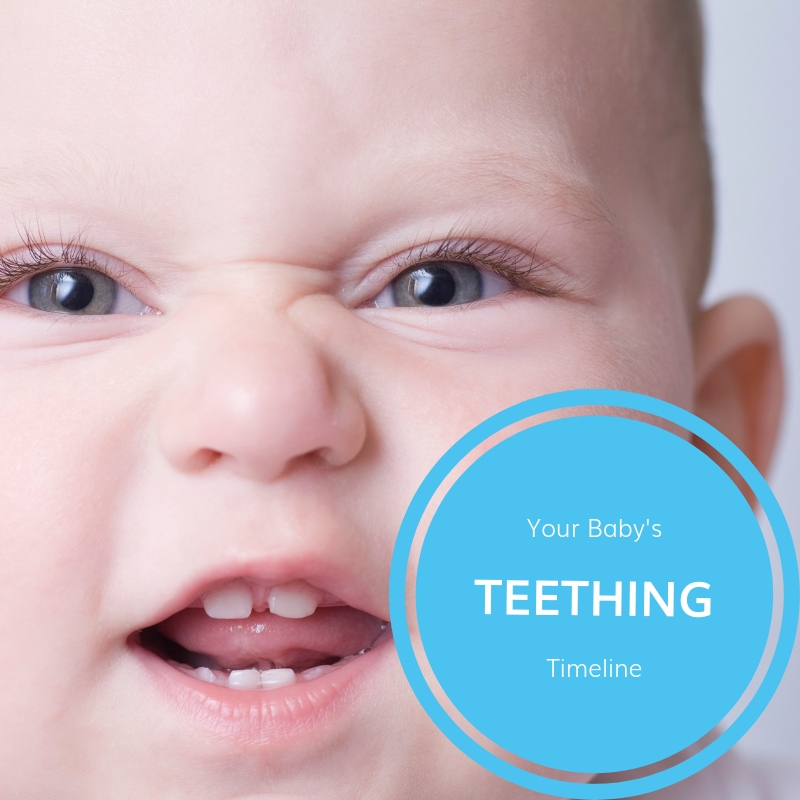No matter what stage your child’s teeth are at, it is important for them to see a dentist.

A pediatric dentist has the proper skills and training to help any child through the different stages of teeth development. A child dentist knows more about this process than any other dentist.
To learn more about the stages listed below, or to schedule an appointment, contact us today!
Stage 1: Baby Teeth Grow In
0 to 6 Months
According to the experts at Colgate, babies typically begin teething around their fourth month. However, every baby is a little different. Be on the lookout for signs like rubbing their gums, decreased appetite, or drooling.
A child’s first tooth will start to come in around their first six to twelve months. Most often the first teeth to come in are the ones in the middle of the mouth. From this point on teeth will continue to grow in, usually one to two every month. While it varies from child to child, by their 3rd birthday mostly all of the baby teeth should be visible, 20 teeth in total.
6 to 10 Months
At this short stage, teeth typically begin to push through the gums. According to many pediatric dentists, the upper and lower front teeth are usually the first to come in.
Tooth Eruption
The term “eruption” may sound alarming, but it simply means the process by which a child’s first teeth, also known as primary, baby or deciduous teeth, break through the gums and appear in the mouth.
Babies are born with most of these teeth already formed, so this is a completely natural and usually trouble-free process, though it often causes temporary discomfort.
The proper development of these baby teeth is important in helping young children start on solid food and in learning to speak.
Tooth Eruption is a process lasting several years is naturally subject to wide individual variations, but certain things are commonly observed –
- girls’ teeth usually appear earlier than those of boys;
- lower teeth normally appear before the upper;
- teeth generally appear two at a time; and
- during the period when both baby and adult teeth are present, the baby teeth will be identifiable as smaller and whiter than the adult.
10 to 14 Months
Next, your child’s primary molars will start to grow. You may notice increased fussiness, your child chewing on objects, and drooling. Some kids may have trouble sleeping at night.
16 to 22 Months
Stage 3 symptoms will continue here. Your child’s remaining molars and canine teeth will grow in at around this age. You may want to ask your dentist for tips to keep your child comfortable.
25 to 33 Months
Your child’s largest molars will grow in and you may notice an increase in fussiness. Older tricks to soothe them may wear a little thin, but fortunately, this is the last stage of teething.
Tips for Teething
- offer a chilled (not frozen) washcloth
- buy teething rings
- wipe away drool promptly
- rock or sing to your child
- offer hard vegetables (watch your child)
- avoid giving sweets
Why Baby Teeth Matter
Many people don’t consider the maintenance and care of baby teeth as a priority. This mistaken belief leads to harmful habits that disrupt a child’s development of healthy adult teeth.
- Primary Teeth – These are the set of teeth infants are born with, commonly called baby teeth. They usually erupt when children are about six months old, with most children having a full set of twenty by the age of 3.
- Jaw Development – Baby teeth hold spaces in the jaw. This ensures that adult teeth slide into their correct spot when they begin coming in at around age 6. Adult teeth push through to any available space when baby teeth are missing, causing crooked or overcrowded teeth.
- Speech – Baby teeth keep a child’s tongue in place as they learn to speak. Absent teeth lead to difficulties in children’s ability to communicate, causing confidence and speech issues.
- Nutrition – Baby teeth allow children to break down complex foods to absorb nutrients that can’t be obtained from milk alone. Unhealthy baby teeth prevent children from eating properly, leaving them vulnerable to health issues related to lack of proper nutrition.
Stage 2: Baby Teeth Fall Out
Around the age of 6 is when a child’s first tooth will fall out, and it is usually one of the two front teeth. Over the course of the next 6 years, a child’s teeth will fall out as their permanent teeth grow under them. It is important during this time to make sure the permanent teeth are growing in properly. This is another reason why your child should continue to see their dentist.
Should You Save Baby Teeth?
There is one very good reason to consider doling out a few dollars, telling the Tooth Fairy to back off, and save baby teeth: Those baby teeth could actually save your child’s life one day!
You’ve likely heard about the benefits of preserving an infant’s umbilical cord, which can later be used to procure life-saving stem cells. According to the International Cord Blood Society, these stem cells have been used in lieu of bone marrow transplants to treat more than 80 diseases including leukemia, Hodgkin’s disease, multiple myeloma, and diabetes. But did you know that freshly plucked baby teeth also boast extractable stem cells that can be cryogenically preserved for later use by your child or other close relatives?
Dozens of companies offering tooth preservation and stem cell extraction have cropped up in the last decade in hopes of being a part of this potentially life-saving trend. However, timing is critical, with a mere 48-hour window from the time the baby tooth is pulled until it reaches the laboratory to undergo the extraction process. The tooth’s dental pulp must have had recent access to blood flow in order to have viable stem cells, so you’ll need to plan ahead and have a company provided ‘tooth kit’ on hand should you choose to save baby teeth.
Parents should immediately take possession of the lost tooth and carefully follow the instructions on the tooth kit. Generally, this involves placing the tooth in a container filled with a preservation solution and ship it to the lab via overnight delivery. The lab will then harvest viable stem cells and store them – for a price, of course. You should also speak to your child’s practitioner on their next early dental care appointment to learn more about the process and its promising outlook.
Stage 3: Permanent Teeth Grow In
The final stage of teeth development is when all the permanent teeth come in. This stage occurs during and after stage 2. A normal person will have a total set of 32 permanent teeth come in. Most will be visible by age 13, but wisdom teeth can appear a few years later, around the age of 17. Permanent teeth are there to stay, so it is incredibly important to make sure a child is taking care of their teeth. Also, if teeth are not coming in properly, an orthodontist may be required to straighten a child’s teeth.
Potomac Pediatric Dentistry offers dental care for children from teething age on. Get your child started early for a beautiful, lifelong smile: contact us today to schedule an appointment.
